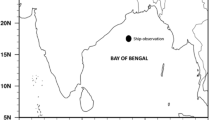Abstract
The diagnostic model of the cumulus convection proposed by Yanai et al. (1973) was applied to the atmosphere over the Tibetan Plateau, and used to estimate the vertical mass flux, entrainment and detrainment, excess temperature and moisture, liquid water content, and condensation and precipitation rates of highland cloud clusters. The results illustrated that in clouds over the Tibetan Plateau, the water vapor condensation rate, liquid water content, and efficiency of the rain generation process are less than those in the tropics (represented by the Marshall Islands region). Therefore, the condensational latent heat released over the Tibetan Plateau, overall, is much smaller than that in the tropics. The water vapor and liquid water detrainment from shallow nonprecipitating cumulus clouds, and their entrainment into deep cumulus clouds, serve as a growing mechanism for the deep precipitating cumulus towers over the Tibetan Plateau. It should be noted that there is a stronger detrainment of liquid water from cumulus clouds and a stronger re—evaporation rate in environment. The process of the condensation—detrainment—re—evaporation— entrainment is repeatedly in progress. It would play an important role in maintaining of cumulus convection on the condition that the supply of moisture is not plentiful over the Tibetan Plateau.
The analyses also showed that the cloud mass fluxM c over the Tibetan Plateau is less, and the large—scale average upward motion is much less than those over the Marshall Islands. Stronger compensating downward motion in the cloud environment over the Tibetan Plateau, responsible for the area's strong environmental heating rate was revealed, and would link to the stability of the South Asian High in summer.
Similar content being viewed by others
References
Arakawa, A. and W. H. Schubert, (1974), Interaction of a cumulus cloud ensemble with the large—scale environment Part 1,J. Atmos. Sci.,31: 674–701.
Chen, L. X., E. R. Reiter and Z. Q. Feng, (1985a), The atmospheric heat source over the Tibetan Plateau: May—August 1979,Mon. Wea. Rev.,113: 1771–1790.
Chen, L. X., T. Y. Duan and W. L. Li, (1985b), The variation of atmospheric heat source and the budget of atmospheric energy over the Qinghai—Xizang Plateau during summer 1979, Acta Meteor. Sinica, 43(1) (in Chinese).
Cho, H. R., (1977), Contributions of cumulus cloud life—cycle effects to the large—scale heat and moisture budget equations,J. Atmos. Sci.,34: 87–97.
—, L. Cheng and R. M. Bloxam, (1979), The representation of cumulus cloud effects in the large—scale vorticity equation,J. Atmos. Sci.,36: 127–139.
Flohn, H., (1968), Contributions to a meteorology of the Tibetan Highlands,Atmos. Sci. Paper, No. 130, Atmospheric Science Department, Colorado State University, Fort Collins, CO 80523, 120 pp.
Katayama, A., (1967), On the radiation budget of the troposphere over the northern hemisphere (iii),J. Meteor. Soc. Japan. 45: 26–38.
Kuo, H. L. (1965), On formation and intensification of tropical cyclones through latent heat release by cumulus convection,J. Atmos. Sci.,22: 40–63.
—, (1974), Further studies of the parameterization of the influence of cumulus convection on large—scale flow,J. Atmos. Sci.,31: 1232–1240.
Kuo, H. B. and M. Yanai, (1984), The large—scale circulation and heat sources over the Tibetan Plateau and surrounding areas during the early summer of 1979, Part II: Heat and moisture budgets,Mon. Wea. Rev.,112: 966–989.
Nitta, T., (1975), Observational determination of cloud mass flux distributions,J. Atmos. Sci.,32: 73–91.
Ogura, Y. and H. R. Cho, (1973), Diagnostic determination of cumulus cloud populations from observed large—scale variables,J. Atmos. Sci.,30: 1276–1286.
Qian, Z. A., S. M. Zhang and F. M. Shan, (1984), The analyzes of the convective cloud in the Tibetan area during summer 1979,The collected papers of QXPMEX (1), Science Press, Beijing, 243–257.
Qiu, H. D., H. S. Zhou, J. X. Liu, X. R. Yang and Z. Qu, (1984), The statistical features of the convective precipitation echo in Nagqa area of the Tibetan Plateau,The collected papers of QXPMEX (1), Science Press, Beijing, 258–268.
Yanai, M., S. Esbensen and J. H. Chu, (1973), Determination of bulk properties of tropical cloud clusters from large—scale heat and moisture budgets,J. Atmo. Sci.,30: 611–627.
Yeh, T. C. and Y. X. Gao, (1979),The meteorology of the Qinghai-Xizang Plateau, Science Press, Beijing 278 pp. (in Chinese).
Zhu, F. K., L. H. Lu, X. G. Chen and W. Zhao, (1980),The South Asian High, Science Press, Beijing, 95 pp. (in Chinese).
Author information
Authors and Affiliations
Rights and permissions
About this article
Cite this article
Tingyang, D., Reiter, E.R. Some characteristics of cumulus convection over the Tibetan Plateau. Adv. Atmos. Sci. 7, 87–97 (1990). https://doi.org/10.1007/BF02919171
Received:
Issue Date:
DOI: https://doi.org/10.1007/BF02919171



